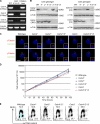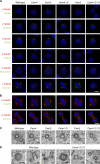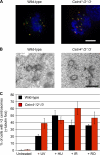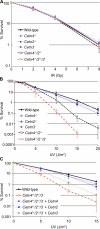Defective nucleotide excision repair with normal centrosome structures and functions in the absence of all vertebrate centrins
- PMID: 21482720
- PMCID: PMC3080269
- DOI: 10.1083/jcb.201012093
Defective nucleotide excision repair with normal centrosome structures and functions in the absence of all vertebrate centrins
Abstract
The principal microtubule-organizing center in animal cells, the centrosome, contains centrin, a small, conserved calcium-binding protein unique to eukaryotes. Several centrin isoforms exist and have been implicated in various cellular processes including nuclear export and deoxyribonucleic acid (DNA) repair. Although centrins are required for centriole/basal body duplication in lower eukaryotes, centrin functions in vertebrate centrosome duplication are less clear. To define these roles, we used gene targeting in the hyperrecombinogenic chicken DT40 cell line to delete all three centrin genes in individual clones. Unexpectedly, centrin-deficient cells underwent normal cellular division with no detectable cell cycle defects. Light and electron microscopy analyses revealed no significant difference in centrosome composition or ultrastructure. However, centrin deficiency made DT40 cells highly sensitive to ultraviolet (UV) irradiation, with Cetn3 deficiency exacerbating the sensitivity of Cetn4/Cetn2 double mutants. DNA damage checkpoints were intact, but repair of UV-induced DNA damage was delayed in centrin nulls. These data demonstrate a role for vertebrate centrin in nucleotide excision repair.
Figures






Similar articles
-
Calcium-binding capacity of centrin2 is required for linear POC5 assembly but not for nucleotide excision repair.PLoS One. 2013 Jul 2;8(7):e68487. doi: 10.1371/journal.pone.0068487. Print 2013. PLoS One. 2013. PMID: 23844208 Free PMC article.
-
Such small hands: the roles of centrins/caltractins in the centriole and in genome maintenance.Cell Mol Life Sci. 2012 Sep;69(18):2979-97. doi: 10.1007/s00018-012-0961-1. Epub 2012 Mar 30. Cell Mol Life Sci. 2012. PMID: 22460578 Free PMC article. Review.
-
Differential requirements for the EF-hand domains of human centrin 2 in primary ciliogenesis and nucleotide excision repair.J Cell Sci. 2019 Oct 3;132(19):jcs228486. doi: 10.1242/jcs.228486. J Cell Sci. 2019. PMID: 31492759
-
Centrin 3 is an inhibitor of centrosomal Mps1 and antagonizes centrin 2 function.Mol Biol Cell. 2015 Nov 1;26(21):3741-53. doi: 10.1091/mbc.E14-07-1248. Epub 2015 Sep 9. Mol Biol Cell. 2015. PMID: 26354417 Free PMC article.
-
Structural Basis for the Functional Diversity of Centrins: A Focus on Calcium Sensing Properties and Target Recognition.Int J Mol Sci. 2021 Nov 10;22(22):12173. doi: 10.3390/ijms222212173. Int J Mol Sci. 2021. PMID: 34830049 Free PMC article. Review.
Cited by
-
Human SFI1 and Centrin form a complex critical for centriole architecture and ciliogenesis.EMBO J. 2022 Nov 2;41(21):e112107. doi: 10.15252/embj.2022112107. Epub 2022 Sep 20. EMBO J. 2022. PMID: 36125182 Free PMC article.
-
Nucleotide excision repair genes shaping embryonic development.Open Biol. 2019 Oct 31;9(10):190166. doi: 10.1098/rsob.190166. Epub 2019 Oct 30. Open Biol. 2019. PMID: 31662099 Free PMC article. Review.
-
Sfr1, a Tetrahymena thermophila Sfi1 Repeat Protein, Modulates the Production of Cortical Row Basal Bodies.mSphere. 2016 Nov 16;1(6):e00257-16. doi: 10.1128/mSphere.00257-16. eCollection 2016 Nov-Dec. mSphere. 2016. PMID: 27904881 Free PMC article.
-
Centriolar subdistal appendages promote double-strand break repair through homologous recombination.EMBO Rep. 2023 Oct 9;24(10):e56724. doi: 10.15252/embr.202256724. Epub 2023 Sep 4. EMBO Rep. 2023. PMID: 37664992 Free PMC article.
-
Centrosome Remodelling in Evolution.Cells. 2018 Jul 6;7(7):71. doi: 10.3390/cells7070071. Cells. 2018. PMID: 29986477 Free PMC article. Review.
References
-
- Acu I.D., Liu T., Suino-Powell K., Mooney S.M., D’Assoro A.B., Rowland N., Muotri A.R., Correa R.G., Niu Y., Kumar R., Salisbury J.L. 2010. Coordination of centrosome homeostasis and DNA repair is intact in MCF-7 and disrupted in MDA-MB 231 breast cancer cells. Cancer Res. 70:3320–3328 10.1158/0008-5472.CAN-09-3800 - DOI - PMC - PubMed
-
- Araki M., Masutani C., Takemura M., Uchida A., Sugasawa K., Kondoh J., Ohkuma Y., Hanaoka F. 2001. Centrosome protein centrin 2/caltractin 1 is part of the xeroderma pigmentosum group C complex that initiates global genome nucleotide excision repair. J. Biol. Chem. 276:18665–18672 10.1074/jbc.M100855200 - DOI - PubMed
Publication types
MeSH terms
Substances
LinkOut - more resources
Full Text Sources
Other Literature Sources

